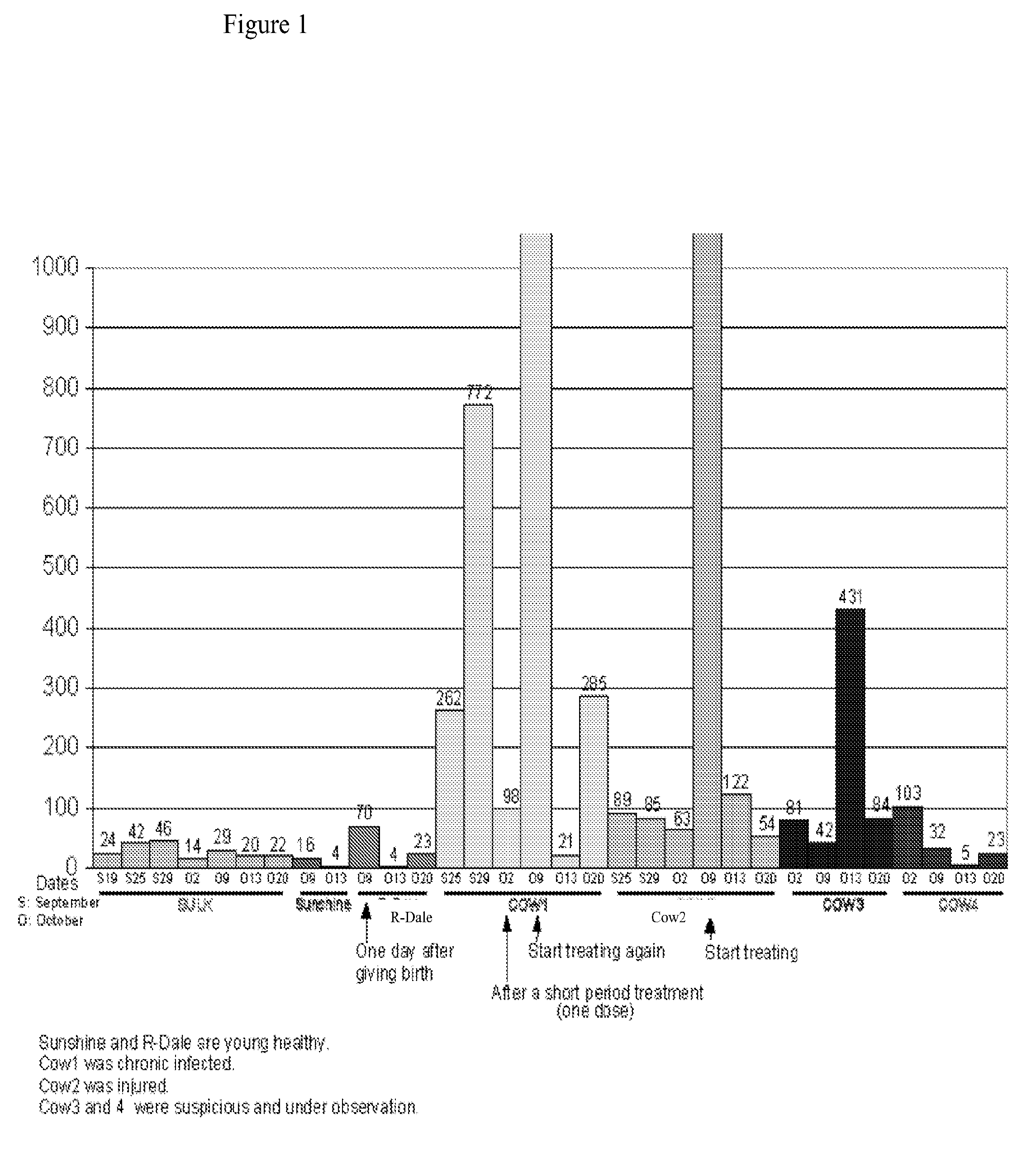Systems for and Methods of Detecting Mastitis
a detection system and mastitis technology, applied in the field of systems for and methods of detecting mastitis, can solve the problems of not knowing if yeast/fungi can aggravate infection caused, affecting the quality of the entire milk output of a dairy facility, and the milking process itself is highly conduciv
- Summary
- Abstract
- Description
- Claims
- Application Information
AI Technical Summary
Benefits of technology
Problems solved by technology
Method used
Image
Examples
example 1
[0108]The methods and systems provided are particularly useful for the early detection of mastitis and monitoring or treatment for various milk producing animals such as the dairy cow. However, the methods are broadly applicable to other organisms, including human, and to other conditions such as malignant growth and pathology. The method involves detecting the abundance and activity of the ubiquitin / proteasome pathway in a sample of unprocessed (raw) milk, wherein an increase in proteasome activity in the sample, as compared to a control, is indicative of mastitis. The invention also includes detecting the level of ancillary proteins of the ubiquitin / proteasome pathway and of the immunoproteasome. In a different embodiment of this Invention the mRNA expression of components of the ubiquitin / proteasome pathway will be measured using variations of polymerase chain reaction-based amplification. Oligonucleotide-based detection of released nuclear DNA from somatic cells is also envision...
example 2
[0130]Proteasome activity using fluorogenic peptide substrates to monitor chymotryptic, tryptic and caspase-like activities,
[0131]proteasome activity using fluorogenic substrates to detect de-ubiquitylation activity,
[0132]proteasome subunit abundance is determined using high-affinity immunologic methods,
[0133]the levels of ubiquitin, multi-ubiquitin, and ubiquitinated substrates can be determined using immunologic methods,
[0134]the assembly of catalytically active 26S proteasomes, from its component 19S and 20S particles, is measured
[0135]the level of the ‘Immunoproteasome’ and the associated PA28 / 13S complex, and novel 20S catalytic particle, is determined using immunologic methods.
example 3
Measure Proteasome (Chymotryptic) Activity Using Fluorogenic Substrate
[0136]Raw milk (50 μl) is suspended in 500 μl lysis buffer (50 mM HEPES, pH 7.5, 150 mM NaCl, 5 mM EDTA and 1% Triton X-100), lysed by sonication, and total protein quantified using the Bradford assay (BioRad). Protein extracts contain a protease inhibitor cocktail (Roche), to prevent non-proteasomal proteolysis. Protein extracts (20 μg) are characterized in triplicate in a 96-well microtiter plate. Reactions are incubated for 5 min at room temperature, in the presence or absence of the proteasome inhibitors epoxomicin and lactacystin. Proteasome activity is determined by examining the hydrolysis of SUC-LLVY-AMC (Boston Biochem), in 25 mM HEPES pH 7.5, 0.5 mM EDTA. Each reaction, containing 40 μM of SUC-LLVY-AMC, is incubated for 1 h at 30° C., and the fluorescence signal quantified over time using a TECAN Infinite F200 plate reader. Proteasome activity is calculated after subtracting non-specific activity that is...
PUM
| Property | Measurement | Unit |
|---|---|---|
| volume | aaaaa | aaaaa |
| time | aaaaa | aaaaa |
| length | aaaaa | aaaaa |
Abstract
Description
Claims
Application Information
 Login to View More
Login to View More - R&D
- Intellectual Property
- Life Sciences
- Materials
- Tech Scout
- Unparalleled Data Quality
- Higher Quality Content
- 60% Fewer Hallucinations
Browse by: Latest US Patents, China's latest patents, Technical Efficacy Thesaurus, Application Domain, Technology Topic, Popular Technical Reports.
© 2025 PatSnap. All rights reserved.Legal|Privacy policy|Modern Slavery Act Transparency Statement|Sitemap|About US| Contact US: help@patsnap.com



